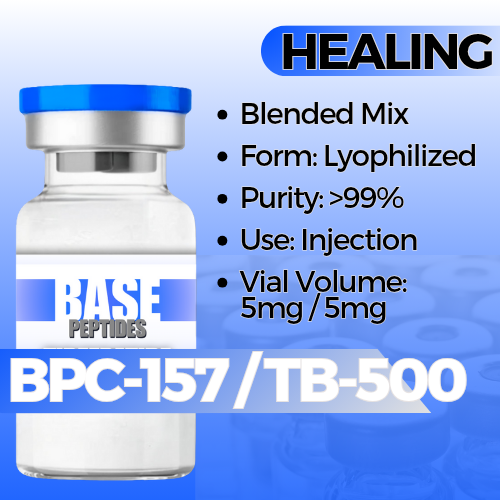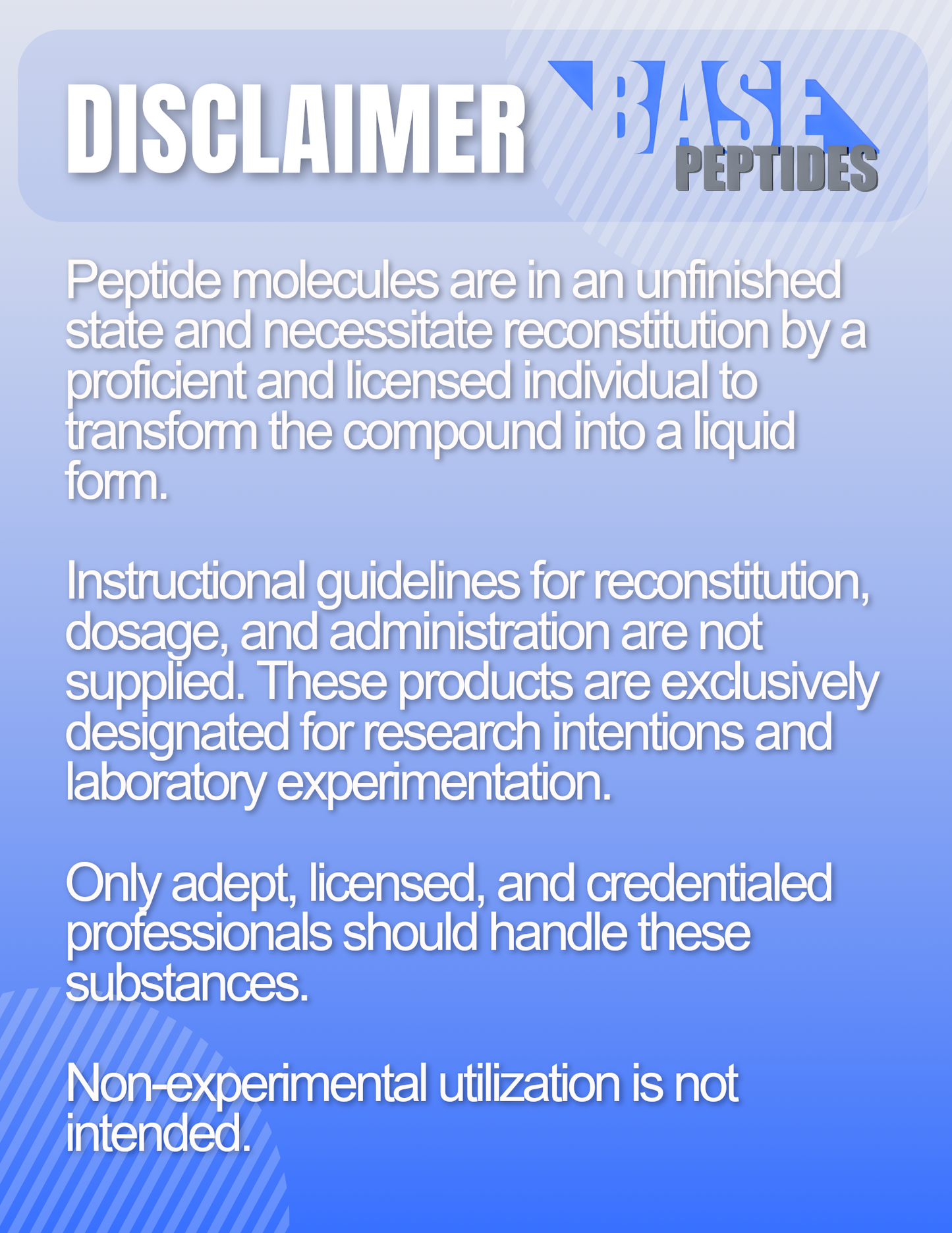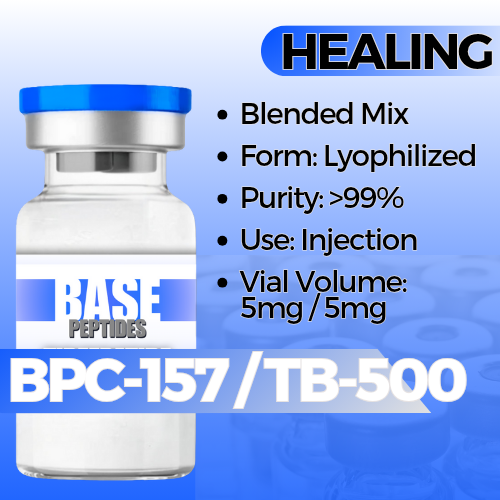BPC-157 & TB-500
BPC-157 & TB-500
Base Peptides are intended for licensed medical professionals and experienced researchers. Reconstitution required. Dosing and use instructions are not provided.
Couldn't load pickup availability
BPC-157 + TB-500 — Research Blend (Barrier Peptide + Thymosin-β4 Fragment)
This blended mix combines BPC-157 (a gastric “Body Protection Compound” fragment) with a research fragment of Thymosin-β4 (TB-500). It’s designed for laboratories studying cell migration, cytoskeleton dynamics, ECM remodeling, angiogenic signaling, and barrier integrity in tissue models.
- CAS: 137525-51-0
- Sequence (15 aa): GEPPPGKPADDAGLV
- Notes: Synthetic fragment derived from a gastric protein; used to explore barrier support, angiogenic cues, and cell migration in vitro/in vivo models.
- Parent protein: Thymosin-β4 (Tβ4, 43 aa)
- Fragment: Research-grade Tβ4-derived sequence (TB-500); focuses on actin binding/motility and cell migration pathways.
- Notes: Often studied for effects on cytoskeleton reorganization, angiogenesis markers, and matrix remodeling.
- BPC-157 is frequently used for barrier/ECM context (endothelium, epithelium, tendon/ligament models) and signaling that supports migration & angiogenic cues.
- TB-500 brings complementary actin-motility biology and cell-movement dynamics, useful in wound-closure and sprouting assays.
- Together, the blend allows labs to test ECM + motility + angiogenic endpoints in a single protocol, with options to vary ratios for mechanism mapping.
Potential Research Applications
Cell Migration & Motility
- Scratch (“wound-healing”) assays and live-cell tracking
- Actin polymerization / focal adhesion markers
ECM & Barrier Integrity
- Trans-epithelial electrical resistance (TEER)
- Collagen I/III, laminin, and MMP/TIMP panels
Angiogenesis Panels
- Tubulogenesis, sprouting, and VEGF-pathway readouts
- Pericyte–endothelial co-culture systems
Blend Options (Research Configurations)
Standard
- 1:1 mass ratio (BPC:TB)
- Balanced ECM + motility coverage
ECM-Forward
- 2:1 (BPC-heavy)
- Emphasis on barrier metrics and collagen markers
Motility-Forward
- 1:2 (TB-heavy)
- Emphasis on actin dynamics and migration speed
Design Notes
- Pre-define primary endpoints (migration rate, TEER change, tubule length).
- Specify salt form and end-groups (e.g., acetate, amidation) on each component in your methods.
- Document vehicle (pH, ionic strength) — ECM and cytoskeletal readouts are condition-sensitive.
Key Study Themes (Educational Summary)
BPC-157 — barrier & ECM signaling
- Frequently reported to influence endothelial/epithelial integrity and angiogenic cues in preclinical models.
- Common endpoints: TEER, tight-junction proteins, collagen expression, and in vitro tubulogenesis.
TB-500 — actin & motility biology
- Derived from Tβ4 research; used to study G-actin binding, cell motility, and sprouting in migration assays.
- Common endpoints: wound-closure rate, actin staining, focal-adhesion proteins, and angiogenic sprout length.
Synergistic Peptides (for Study Design)
GHK-Cu
- Why pair: ECM/trophic gene programs; complements collagen/repair markers.
- Angle: Matrix + angiogenesis arrays with imaging of collagen deposition.
LL-37
- Why pair: Epithelial defense and wound-closure context to round out barrier biology.
- Angle: Co-culture wound models with cytokine readouts.
Tα1 (Thymosin-α1)
- Why pair: Immune-context studies (innate→adaptive) alongside ECM/motility endpoints.
- Angle: Cytokine panels + barrier integrity under challenge.
Controls
- Include vehicle-only and single-agent arms to separate blend effects.
- Add timing (co- vs post-challenge) and dose-response curves for mechanism clarity.
Known Concerns (Context)
- Co-formulation: Verify compatibility (pH, buffer salts, preservatives) before blending; avoid unnecessary excipients that can confound cell assays.
- Stability: Prepare fresh aliquots; minimize freeze–thaw cycles; protect from light/moisture.
- Model variability: Migration/ECM endpoints can vary with serum lots, substrate coatings, and cell passage number — document conditions tightly.
- General: For laboratory research use only; not for human consumption or therapeutic use.
Specifications & Handling
- Form: Lyophilized powders blended to order (lot-coded)
- Purity (each component): ≥ 99% (HPLC/MS verified)
- Storage: ≤ −20 °C; dry, low-light conditions
- In solution: Use sterile diluent; record pH/vehicle; aliquot immediately; avoid repeat freeze–thaw
- Packaging: Tamper-evident; research-only labeling; blend ratio indicated on label
Regulatory & Use Notice
Sold for laboratory research use only. Not for human consumption, medical, or veterinary use. No human-use instructions are provided. Buyer is responsible for safe handling and regulatory compliance.
BPC-157 + TB-500 Research Blend | Barrier Integrity, Actin-Motility & Angiogenesis | ECM & Wound-Model Studies




